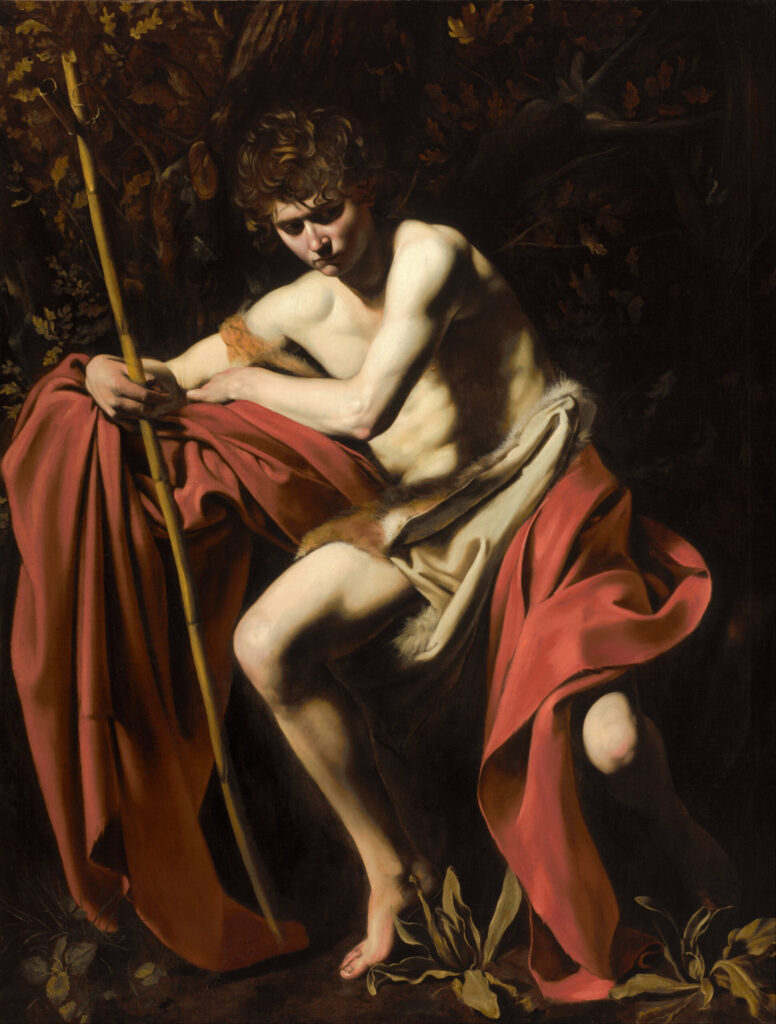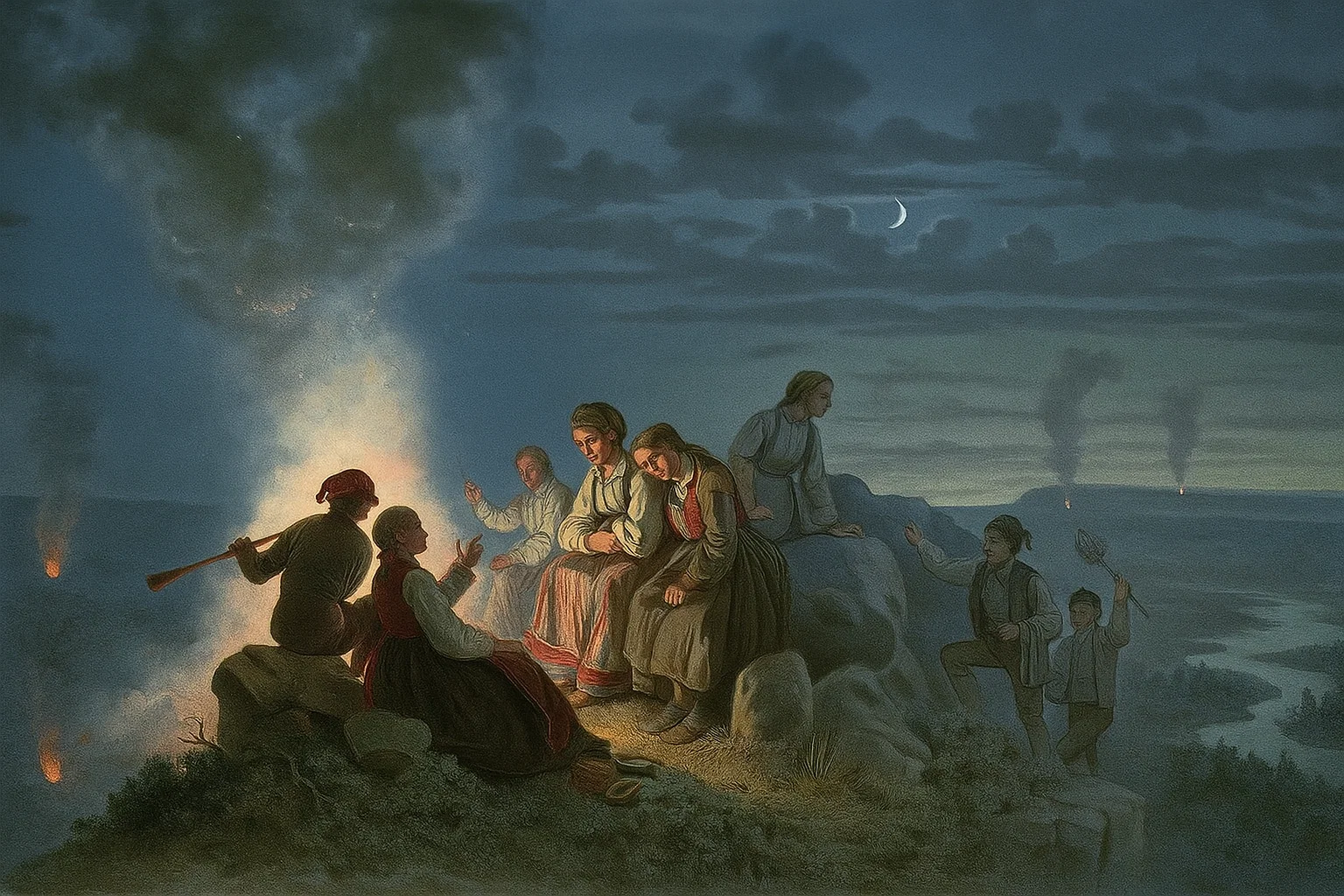To approach the Feast of Saint John is to enter a layered territory where rural festivity conceals ancient codes, where Christian hagiography shadows older mysteries, and where the masculine blaze of the solstice meets a hidden feminine threshold. Officially anchored in the figure of John the Baptist, this midsummer ritual has been absorbed into folk calendars as a celebration of light, purification, and transition. But the true terrain is darker, subtler, more erotic in its architecture. The date itself, fixed just after the solar solstice, marks not a climax but a reversal. As the Sun reaches its maximum strength, it begins to decline. It is in this moment that a tension opens: the excess of solar presence creates a void where the Lady waits, veiled and vigilant.
The fires burn in Her name although Her name is not spoken. The river carries the memory of Her waters. The herbs are gathered beneath Her gaze. What is celebrated as the night of the Forerunner is in truth a coded rite of return to the womb, to the Mother of signs, to the unseen rhythm that governs all things beneath the liturgy of daylight. Saint John, stripped of his ecclesiastical trappings, emerges here as a liminal figure whose role is anticipation, the gesture of opening. In the gnostic imagination, he becomes the guardian of thresholds, the one who baptises into memory rather than doctrine, whose feast preserves the remnants of a lunar liturgy long buried beneath the Cross.
I. Solstitial Excess and the Recoil of Light
The summer solstice is not simply the apex of solar radiance. It is a metaphysical event in which light, having reached its peak, begins to devour itself. In the ancient cosmologies, either gnostic, pagan, hermetic, this overabundance is perilous. Too much light does not illuminate. It blinds, sterilises, burns. The solstice marks the beginning of decline precisely because it dares to surpass the natural balance.
In Christian mysticism, the figure of Saint John the Baptist occupies a unique position: his birth, celebrated at this solar high point, is the only nativity apart from Christ’s to merit a feast. Yet the deeper symbolism rests in the contrast. As Christ is born when light begins to grow, John is born when light begins to fade. The Baptist stands not in glory but in shadow. He decreases so another may increase, not in subservience but in cosmic necessity. His feast is a signal: that the ascent has ended, that another path must open. In the gnostic schema, this is the moment where Sophia withdraws, where the feminine current, scorched by excessive Logos, seeks refuge in silence and image and fluidity.
Fire, celebrated in the night with leaping bodies and laughter, is not an end but a passage. It is the arch through which one must leap to reach the deeper mystery. The true power of the night is not in the blaze, but in the recoil that follows. Those who leap over the fire re-enact an older ritual of transgression and return. The feast becomes a hinge in the year’s wheel, a moment where light itself becomes suspicious, and the seeker must turn toward what is hidden in the earth and the blood.
II. The Waters of the Womb and the Echo of the Prophet
John baptises in water, not fire. And this choice is not trivial. Water, in all esoteric traditions, is the element of return, of disintegration, of gestation. It is the substance of the unconscious, of dreams, of memory too ancient for speech. The Jordan, as geographical marker and as mythic stream, is the site of passage through the maternal gate. To be baptised is not to be washed of sin. It is to be plunged into origin. The rite, when seen through a gnostic eye, is a descent into the lunar current that flows beneath all appearances. It is a return to the body before doctrine, before name, before separation. John does not claim to save. He points. He signals. He refuses identification. He prepares a way, not as architect but as listener. The waters are not his. They are Hers.
In certain heretical lineages, especially among the Mandaeans, John surpasses Christ, precisely because he aligns himself with the feminine mystery of the river, rather than the salvific fire of the Son. And, in the folk rituals of the solstice, this submerged theology remains. The herbs collected at midnight are not botanical curiosities. They are residues of lunar pharmacopoeia, gathered in secrecy and soaked in the logic of cycles. Baths are taken, not for hygiene, but for enchantment. The body is not purified but prepared. The fire may draw the crowd, but it is the river that heals. The prophet, in this symbolic economy, is not the bearer of a new law. He is the voice that echoes from the cavern of the body. He speaks not in command, but in vibration. His is a function of resonance. And so the feast that bears his name, under cover of Christian approval, transmits the memory of rites far older than the Gospel. In the baptismal plunge, the body remembers the wet darkness from which all speech is born.

There is no triumph in this image. There is only the erotic patience of the threshold, the lunar vow of those who do not rush the symbol. He has seen the fire but knows the water comes next. His gaze lowers not from shame but from the weight of receiving something unspeakably vast. This is the moment before the prophecy, the place where the Mother still has his name in Her mouth.
III. She Who Waits: Lunar Eroticism and the Reclamation of Shadow
The most dangerous part of the solstice is not the fire, but the absence it conceals. The Moon, in these summer nights, is often minimal, retreating from the sky, letting the Sun dominate the stage. But it is precisely in that absence that the deepest presence gathers. The Mother withdraws, not to vanish, but to observe. She watches from behind the flame, from within the water, from under the herb. Her eroticism is not the visible lust of daylight, but the charged waiting that infuses the dark with potential.
On the night of Saint John, couples seek one another in fields. Young women place herbs under pillows to dream of future lovers. The erotic rituals are everywhere, encoded in folklore, dismissed as superstition, yet vibrating with ancestral charge. These acts are not naïve. They are fragments of a theology of the body, a lunar erotics that survives despite centuries of repression. The feminine Divine does not speak in commandments. She whispers in desire. She inscribes herself in gesture, in dream, in the scent of burning herbs and the sweat of skin kissed by night air. The Baptist, in this structure, becomes not a rival to Christ but a necessary precursor. He opens the path not only to the Logos, but to the re-entry into the womb of mystery. His voice in the wilderness is the echo of the blood before the Word.
The Mother, long silenced by dogma, uses his feast to reopen Her channels. She does not need a name. She needs a threshold. And the solstice, in its dizzying light, creates just enough shadow for her to move. Those who honour Her do not seek clarity. They seek pulse, recurrence. They do not ascend. They circulate. And, in this circulation, the erotic and the Sacred cease to oppose. They become one current, swelling and ebbing beneath the noise of theology. The night remembers. And it invites the body to remember with it.
Conclusion
The Feast of Saint John, long assumed to be a festival of Christian light, is in truth a tapestry of ancient impulses, woven with the threads of gnostic wisdom, lunar remembrance, and erotic gesture. It is a moment when the tyranny of clarity falters, and the world once again feels the pull of that which cannot be spoken. The fires burn, but they do not dominate. They mark the edge of something older, wetter, more fertile. The river still waits. The herbs still whisper. And, beneath the hymns, the voice of the Prophet echoes not to command, but to call the soul back to what it has forgotten.
The Mother is not absent. She is veiled, She has always been veiled. The feast is Her veil, and the one who knows how to walk through fire, descend into water, and listen to the pulse of plant and dream, walks not into superstition, but into sacrament. On this night, the Lord of Light yields. And the Queen, unseen, prepares the ground anew.
Post-Scriptum: A Balsamic Offering to Levanah
On this night, as the Moon wanes into her balsamic phase in Gemini, Her breath turns inward, toward the hidden chamber of silence and renewal. The sky is thin with memory. The air tastes of something unsaid. If you wish to honour Levanah, veiled Queen of moist breath and mirrored Verbum, you may prepare a rite of soft offering.
At midnight, light a single beeswax candle and place beside it a bowl of fresh river water infused with three herbs gathered that same day. Speak not aloud. Inhale through the nose, deeply, as if drinking silence. Let your palms hover above the bowl, never touching, as if courting the air between skin and water. Then whisper once, without sound, Her name. Not with your mouth, but from the diaphragm of the heart. Remain still for seven breaths. On the eighth, dip your fingers into the water and touch the centre of your chest, your brow, your left wrist.
Say nothing. Let your body receive the mark. Then blow out the candle. Keep the water by your bed. Let the dream come. It is remembrance.
She will answer.
